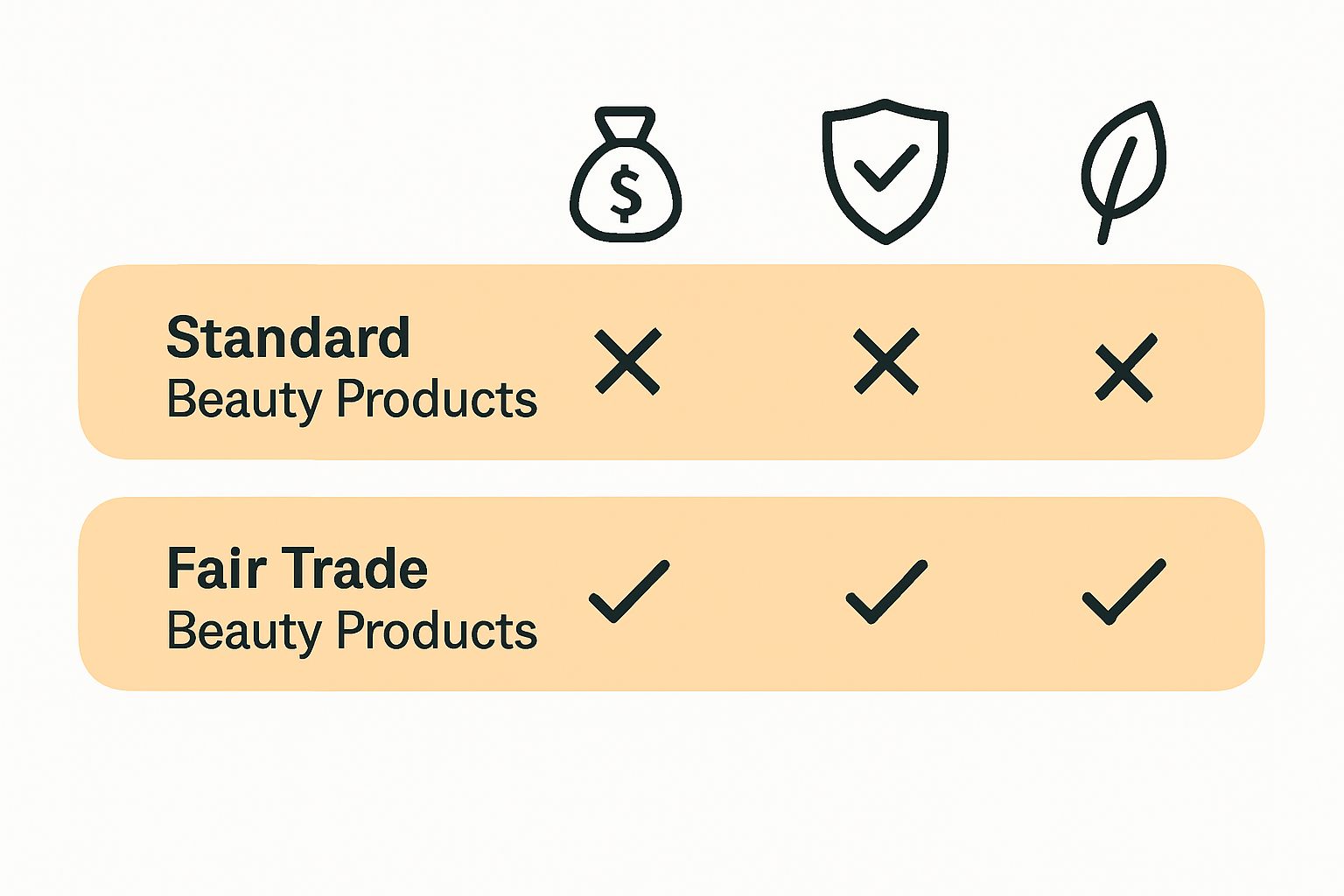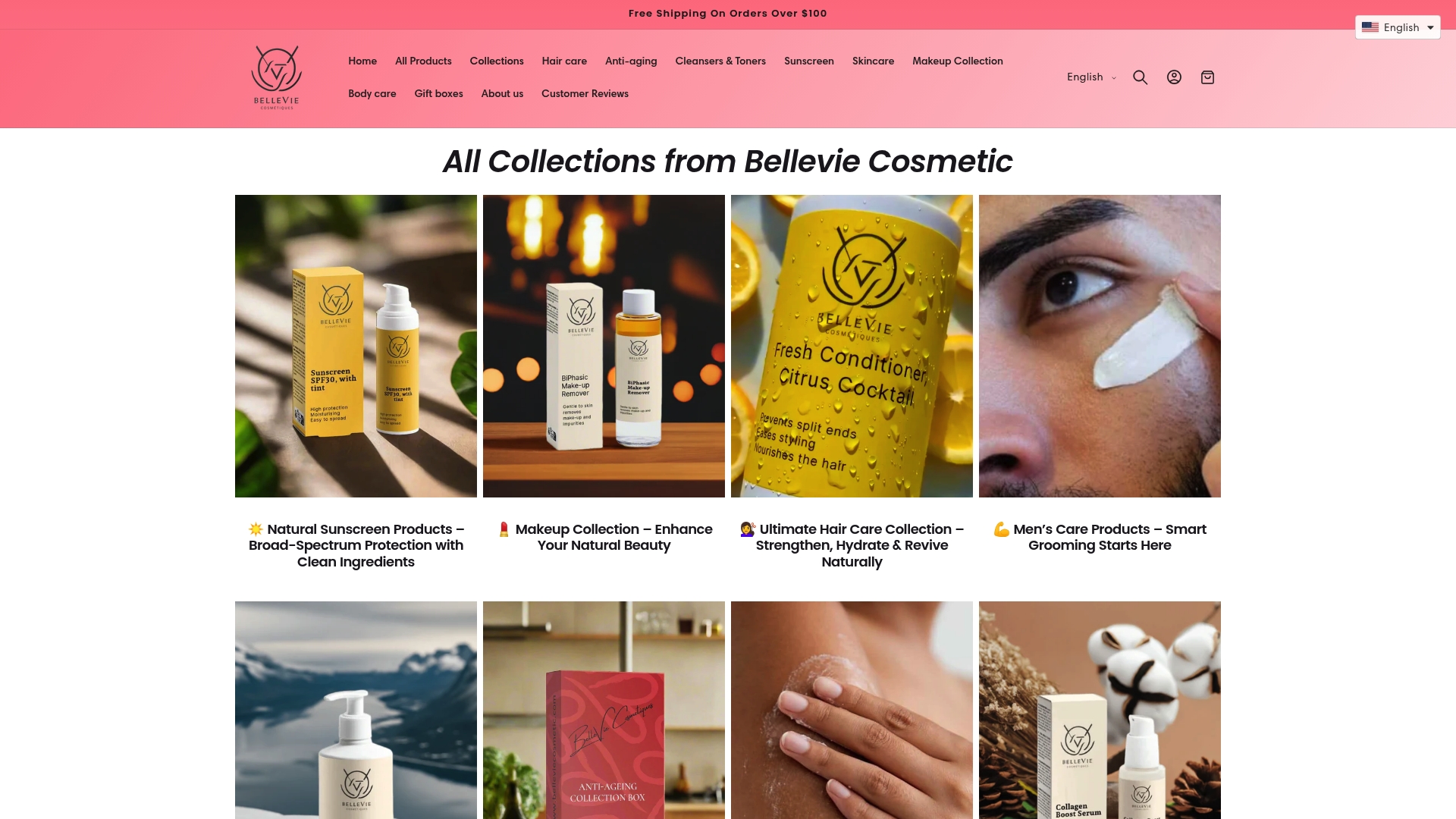Fair trade beauty is making waves, promising not just glowing skin but real change for people and the planet. Most shoppers do not know that ingredients like shea butter from Ghana or argan oil from Morocco travel thousands of miles and impact entire communities by the time they reach your bathroom shelf. It might sound like a niche movement, but fair trade beauty is actually a powerful way for anyone to support economic justice, environmental protection, and better lives worldwide every time they pick up a moisturizer or shampoo.
Table of Contents
- Defining Fair Trade Beauty And Its Origins
- The Importance Of Ethical Sourcing In Beauty Products
- How Fair Trade Standards Impact Quality And Pricing
- The Role Of Certifications In Identifying Fair Trade Beauty
- Real-World Benefits Of Choosing Fair Trade Beauty Products
Quick Summary
| Takeaway | Explanation |
|---|---|
| Fair trade beauty promotes ethical practices. | This approach ensures fair wages and safe conditions for workers in beauty production. |
| Transparent supply chains are essential for trust. | Brands must disclose ingredient sources and labor practices to promote accountability. |
| Quality improves with fair trade standards. | Ethical production often yields superior ingredients due to better compensation and practices. |
| Consumer choices impact global communities. | Purchasing fair trade products supports economic empowerment and sustainability efforts worldwide. |
| Certifications help identify genuine fair trade products. | Look for recognized labels that guarantee adherence to ethical and environmental standards. |
Defining Fair Trade Beauty and Its Origins
Fair trade beauty represents a transformative approach to personal care and cosmetic production that extends far beyond traditional manufacturing practices. At its core, this movement seeks to create ethical, sustainable, and socially responsible systems that protect workers, communities, and the environment.
The Foundational Principles of Fair Trade Beauty
The fair trade beauty concept emerged from broader fair trade principles initially developed in agricultural and craft sectors during the mid-20th century. According to the Fair Trade International Organization, the fundamental goals are to ensure:
- Fair compensation for workers and producers
- Safe and dignified working conditions
- Environmental sustainability
- Prohibition of child labor and forced labor
- Transparent and equitable supply chain practices
These principles translate directly into beauty and skincare production, focusing on ingredients sourced from regions like West Africa, South America, and Southeast Asia.
Below is a table summarizing the foundational principles of fair trade beauty, along with their real-world implications as described in the article.
| Principle | Description |
|---|---|
| Fair Compensation | Ensures workers and producers receive wages above market rates and benefit from financial stability. |
| Safe and Dignified Working Conditions | Guarantees environments free from harm, exploitation, and promotes worker well-being. |
| Environmental Sustainability | Prioritizes sustainable harvesting, reduced chemical use, and protection of natural resources. |
| Prohibition of Child and Forced Labor | Bans exploitative labor practices, protecting vulnerable populations. |
| Transparent and Equitable Supply Chains | Ensures traceability, accountability, and fair treatment at every stage of production. |
Historical Context and Global Impact
The fair trade movement originated as a response to exploitative global trading systems that consistently marginalized small-scale producers. By the 1960s, organizations began developing frameworks to guarantee economic justice for workers in developing countries. In beauty and cosmetics, this meant reimagining how natural ingredients are sourced, processed, and valued.
Modern fair trade beauty goes beyond simple economic transactions. It represents a holistic approach to ethical consumption that empowers local communities, preserves traditional knowledge, and promotes sustainable agricultural practices. Read more about our commitment to ethical sourcing and understand how every product can make a meaningful difference.
Today, fair trade beauty is not just a niche market but a growing global movement. Consumers are increasingly aware that their purchasing decisions can support social justice, environmental protection, and economic empowerment for marginalized communities worldwide.
The Importance of Ethical Sourcing in Beauty Products
Ethical sourcing in beauty products has emerged as a critical consideration for conscious consumers and responsible brands. This approach goes far beyond simple purchasing decisions, representing a comprehensive commitment to social responsibility, environmental stewardship, and human rights protection throughout global supply chains.
Understanding Supply Chain Transparency
Transparency is the cornerstone of ethical sourcing. Brands committed to this practice provide detailed information about ingredient origins, manufacturing processes, and the social conditions of workers involved in product creation. According to the Sustainable Agriculture Network, ethical sourcing involves rigorous verification of labor practices, environmental standards, and community impact.
Key elements of transparent supply chains include:
- Complete traceability of raw materials
- Regular third-party audits of production facilities
- Fair compensation for agricultural and manufacturing workers
- Minimal environmental footprint
- Respect for indigenous knowledge and local communities
Environmental and Social Implications
Ethical sourcing directly addresses several critical global challenges. Traditional beauty ingredient procurement often involves significant environmental degradation and labor exploitation. By contrast, ethical sourcing prioritizes sustainable harvesting methods, biodiversity preservation, and equitable economic development.
For instance, responsible sourcing of palm oil can prevent deforestation, while fair trade practices for ingredients like shea butter can provide economic opportunities for women in West African communities. Explore our commitment to future ethical skincare innovations and understand how thoughtful ingredient selection transforms entire production ecosystems.
Consumers are increasingly recognizing that their beauty product choices have far-reaching consequences.
The following table compares traditional ingredient sourcing in beauty with ethical (fair trade) sourcing, highlighting the environmental and social differences presented in the article.
| Aspect | Traditional Sourcing | Fair Trade/Ethical Sourcing |
|---|---|---|
| Environmental Impact | Often leads to deforestation, degradation | Encourages sustainable harvesting and resource protection |
| Labor Practices | Can involve exploitation and unsafe work | Ensures fair wages, safe conditions, and worker rights |
| Supply Chain | Opaque, limited transparency | Complete traceability and openness to audits |
| Community Impact | Marginalizes local producers | Supports economic empowerment and local development |
| Use of Chemicals | May involve heavy chemical usage | Promotes reduced and safer chemical alternatives |
How Fair Trade Standards Impact Quality and Pricing
Fair trade standards fundamentally transform the economic landscape of beauty product manufacturing, creating a complex interplay between product quality, ethical production, and consumer pricing. These standards represent a holistic approach that goes beyond traditional market dynamics, prioritizing human welfare and environmental sustainability.
Quality Enhancement Through Ethical Practices
Contrary to common misconceptions, fair trade standards often lead to superior product quality. By mandating rigorous production guidelines, these standards ensure meticulous attention to ingredient sourcing, processing, and manufacturing. According to Fairtrade International, fair trade certification requires:
- Comprehensive worker training programs
- Strict quality control mechanisms
- Sustainable agricultural practices
- Preservation of traditional production knowledge
- Continuous improvement of production techniques
These requirements naturally elevate the overall quality of raw materials and finished products. Farmers and producers who receive fair compensation are more likely to invest in advanced cultivation techniques, leading to higher-grade ingredients with enhanced nutritional and aesthetic properties.
Pricing Dynamics and Consumer Perception
Fair trade products typically command a premium price, reflecting the true cost of ethical production. This pricing model encompasses not just the raw materials but also the social and environmental investments made throughout the supply chain. While the initial cost might seem higher, consumers are increasingly recognizing the long-term value of supporting responsible production.

The price difference represents investments in:
- Fair worker wages
- Community development programs
- Environmental conservation efforts
- Sustainable infrastructure
- Ethical business practices
Modern consumers view these additional costs as an investment in global social justice and environmental sustainability. They understand that each purchase is a vote for the kind of economic system they want to support. Explore how ethical skincare innovations drive meaningful change and see how quality and ethics can coexist in the beauty industry.
The Role of Certifications in Identifying Fair Trade Beauty
Certifications serve as critical navigational tools for consumers seeking authentic fair trade beauty products. These official endorsements provide transparent, verifiable evidence that beauty brands meet rigorous ethical, environmental, and social standards throughout their production processes.
Understanding Certification Frameworks
Fair trade certifications are not monolithic but represent a complex ecosystem of standards and verification mechanisms.
This table outlines the key criteria typically assessed by major fair trade certification frameworks in the beauty sector.
| Certification Criteria | What Is Assessed |
|---|---|
| Labor Conditions and Rights | Worker safety, fair wages, and rights protections |
| Environmental Sustainability | Resource conservation, pollution reduction, and biodiversity efforts |
| Community Impact and Development | Investments in education, healthcare, and local infrastructure |
| Supply Chain Transparency | Full traceability of ingredients and production processes |
| Ethical Sourcing of Materials | Use of ingredients harvested or produced in a socially responsible manner |
- Labor conditions and worker rights
- Environmental sustainability practices
- Community impact and economic development
- Supply chain transparency
- Ethical sourcing of raw materials
Globally recognized certification bodies like Fairtrade International, Fair Trade USA, and the World Fair Trade Organization provide comprehensive frameworks that go beyond simple compliance, actively promoting systemic change in global production networks.
Navigating Certification Labels
Consumers must develop critical skills in interpreting certification labels, as not all certifications carry equal weight or significance. Genuine fair trade certifications distinguish themselves through:
- Independent third-party verification
- Comprehensive audit processes
- Strict minimum standards for producer compensation
- Ongoing monitoring and assessment
- Commitment to continuous improvement
These labels represent more than marketing claims — they are tangible proof of a brand’s commitment to ethical production. Explore our comprehensive guide to ethical sourcing to understand how certifications translate into real-world impact. By choosing certified products, consumers become active participants in a global movement towards more just and sustainable economic practices.
Real-World Benefits of Choosing Fair Trade Beauty Products
Choosing fair trade beauty products represents far more than a purchasing decision — it is a transformative act with profound global implications. These choices create tangible, measurable impacts that extend well beyond individual skincare routines, influencing entire communities and ecosystems.
Economic Empowerment and Community Development
Fair trade beauty products directly support economic resilience in marginalized communities. According to Fairtrade International’s research, these practices provide critical economic opportunities by:
- Ensuring stable, above-market wages for producers
- Creating opportunities for women in agricultural and manufacturing sectors
- Supporting local education and healthcare infrastructure
- Developing sustainable agricultural skills
- Reducing dependency on exploitative trading systems
By prioritizing fair compensation, these practices enable communities to invest in long-term economic development, breaking cycles of poverty and creating sustainable livelihoods.
Environmental and Social Sustainability
Fair trade beauty products integrate environmental stewardship with social responsibility. Producers are incentivized to adopt sustainable practices that protect natural resources, preserve biodiversity, and mitigate climate change impacts. This holistic approach addresses multiple global challenges simultaneously.
The environmental benefits include:
- Reduced chemical usage in ingredient production
- Protection of endangered ecosystems
- Promotion of regenerative agricultural techniques
- Conservation of traditional farming knowledge
- Minimized carbon footprint in production processes
Discover how sustainable beauty choices can transform economic landscapes and understand the profound ripple effects of conscious consumption. Each fair trade beauty product purchase represents an investment in a more equitable, sustainable global economic model.

Discover Beauty That Respects People and the Planet
Are you frustrated by beauty standards that ignore fair wages, safe working conditions, and ethical sourcing? The article highlights how fair trade beauty transforms personal care by demanding transparency and integrity at every step. Many people feel lost when trying to choose products that actually honor workers and the environment. At BelleVieCosmetic.com, these values are at the heart of every formula—so you never have to compromise your ideals for results.

Ready to upgrade your routine with skincare that puts ethics into action? Dive into our full selection of natural and organic skincare collections to experience what clean, clinically-backed beauty can achieve. See how we live up to the standards of quality and responsibility discussed in the article. Shop confidently at BelleVieCosmetic.com and know your choices help build a fairer, more sustainable beauty industry. Now is the perfect time to make a difference for your skin and the communities behind every ingredient.
Frequently Asked Questions
What is fair trade beauty?
Fair trade beauty refers to personal care and cosmetic products produced under ethical and sustainable practices. This includes ensuring fair compensation for workers, safe working conditions, and environmentally friendly sourcing methods.
Why is ethical sourcing important in beauty products?
Ethical sourcing is crucial because it promotes social responsibility, environmental protection, and human rights within global supply chains. Supporting ethically sourced beauty products contributes to a more sustainable and equitable economic model.
How do fair trade standards improve product quality?
Fair trade standards enhance product quality by enforcing rigorous guidelines for ingredient sourcing and manufacturing. By prioritizing fair compensation and comprehensive worker training, producers can invest in better cultivation and processing techniques, resulting in higher-grade ingredients.
What should I look for in fair trade certifications?
When looking for fair trade certifications, prioritize labels that feature independent third-party verification and rigorous auditing processes. Genuine certifications ensure ethical practices around labor conditions, environmental impacts, and community benefits.
How does buying fair trade beauty products affect communities?
Purchasing fair trade beauty products supports economic empowerment and community development by guaranteeing fair wages and improved living conditions for producers. This encourages local investment in education and healthcare, contributing to long-term economic resilience.
What are the environmental benefits of fair trade beauty?
Fair trade beauty products promote environmental sustainability by encouraging sustainable harvesting methods and reducing harmful chemicals. By choosing these products, you support practices that preserve biodiversity and minimize the carbon footprint of production.
